-
Discovering Group Theory, Day 12
On Day 12, we continued to explore the group of permutations of finite sets using S3 as an example, but we also practiced calculations with elements of symmetric groups of higher orders.
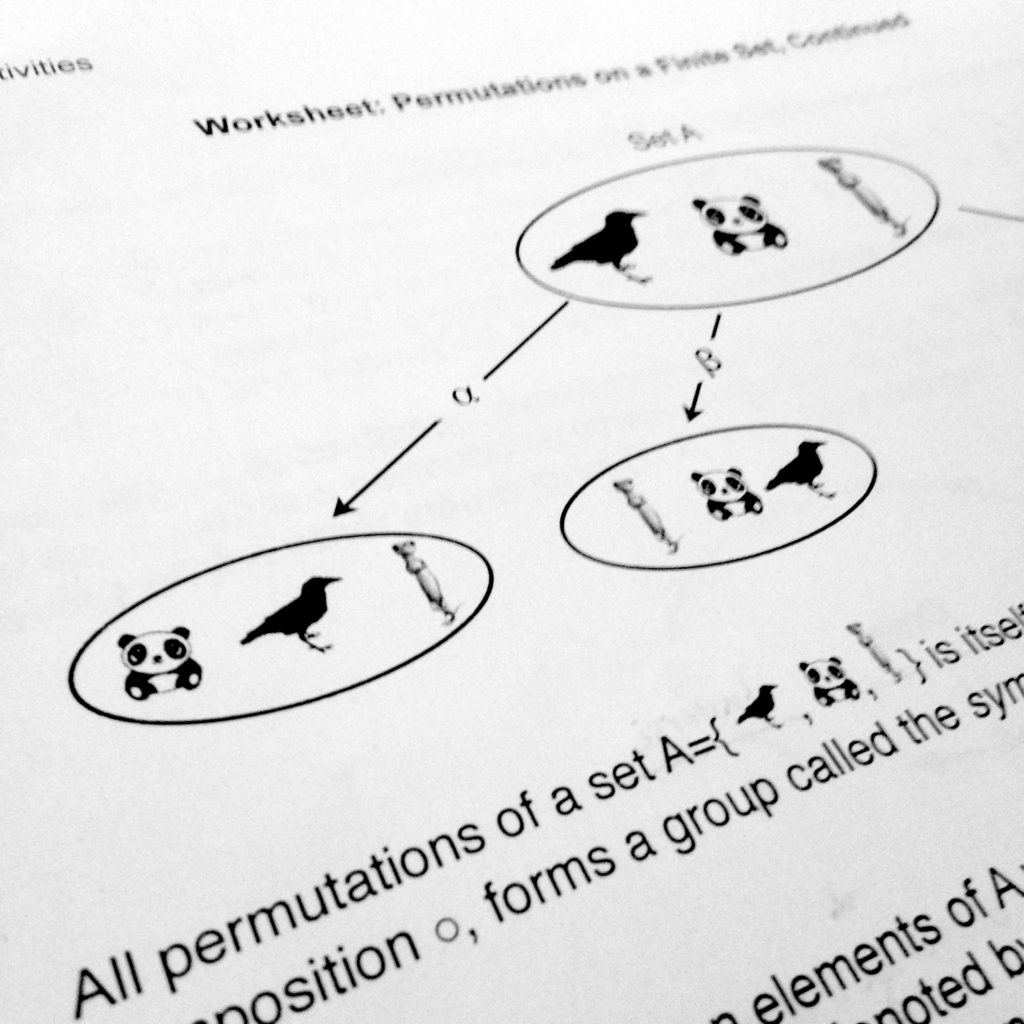
On day 12, more on permutations. In addition to reviewing the concepts of order of an element, inverse, commutativity, we introduced some new concepts:
- Cycles and their properties
- Parity/ Even and odd permutations
Students practiced switching between different notations used to represent permutations, while also checking our answers by physically moving pieces of paper labeled with numbers 1, 2, and 3.

Students carried out permutations of pieces of paper
to either find answers or check them. -
Discovering Group Theory, Day 11
On Day 11, we began with all the grammatically correct ways to say “I love physics” in Bosnian/Croatian/Serbian language. That happens to be a total of 3!=6 ways, each a permutation of “JA VOLIM FIZIKU,” which is pronounced roughly as |ya volim feezikoo|. I couldn’t resist the temptation to bring in my native tongue(s) into the lecture; the students mostly rolled with it. 🙂
- The class started with students constructing the sentences by arranging thee pieces of paper with individual words in all possible orders.
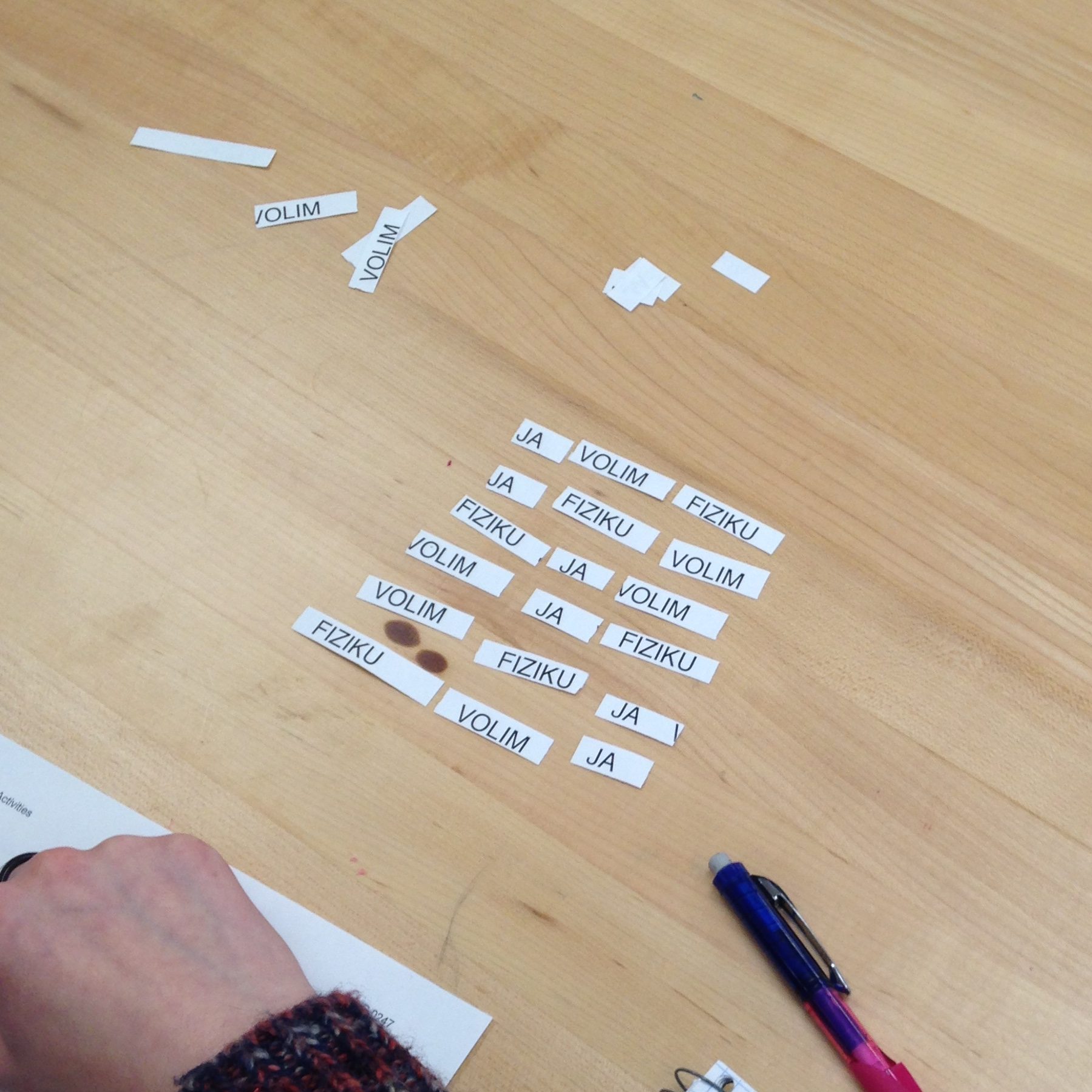
All the ways “I love Physics.”
- Once we figured out all the possible combinations of the three words, we gave a symbol to each permutation taking the original sentence to a different one, as well as the identity.
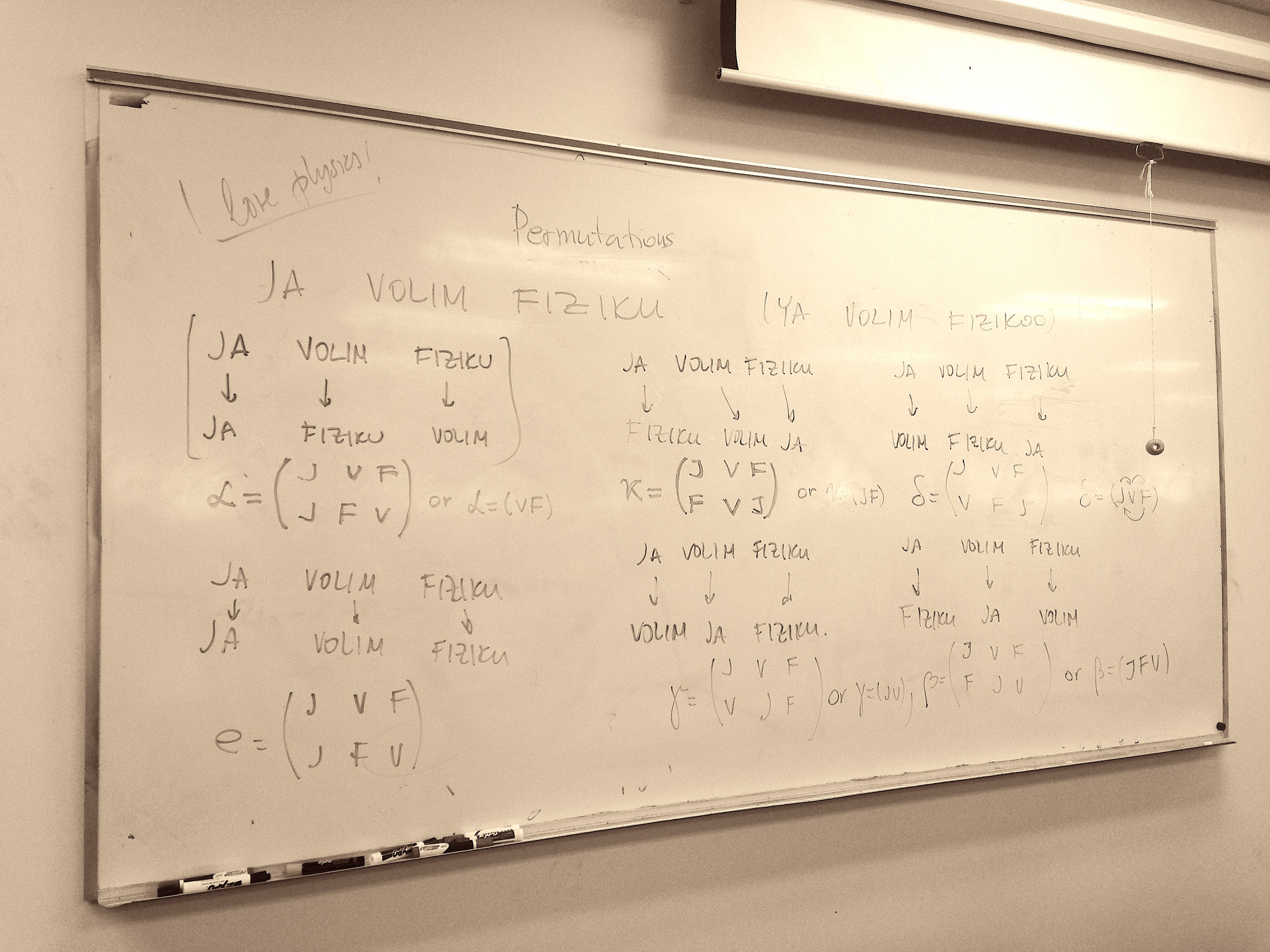 Introducing notation for permutations.
Introducing notation for permutations.- After we clarified what it means to apply permutations successively, students wrote out the multiplication table for the permutations. This was particularly interesting to me because each student seemed to have a different method of tracking the changes after each permutation. Some moved the pieces of paper, some sketched the process by writing the string of words after each permutation, and one kept track of the permutations by creating a “dictionary ” pictured below which he used to track the changes. A subtle question arose of whether the first subsequent permutation was to be applied to the specific words used in the definition of the permutation, or on whichever words were in the original locations of the words from the definition.
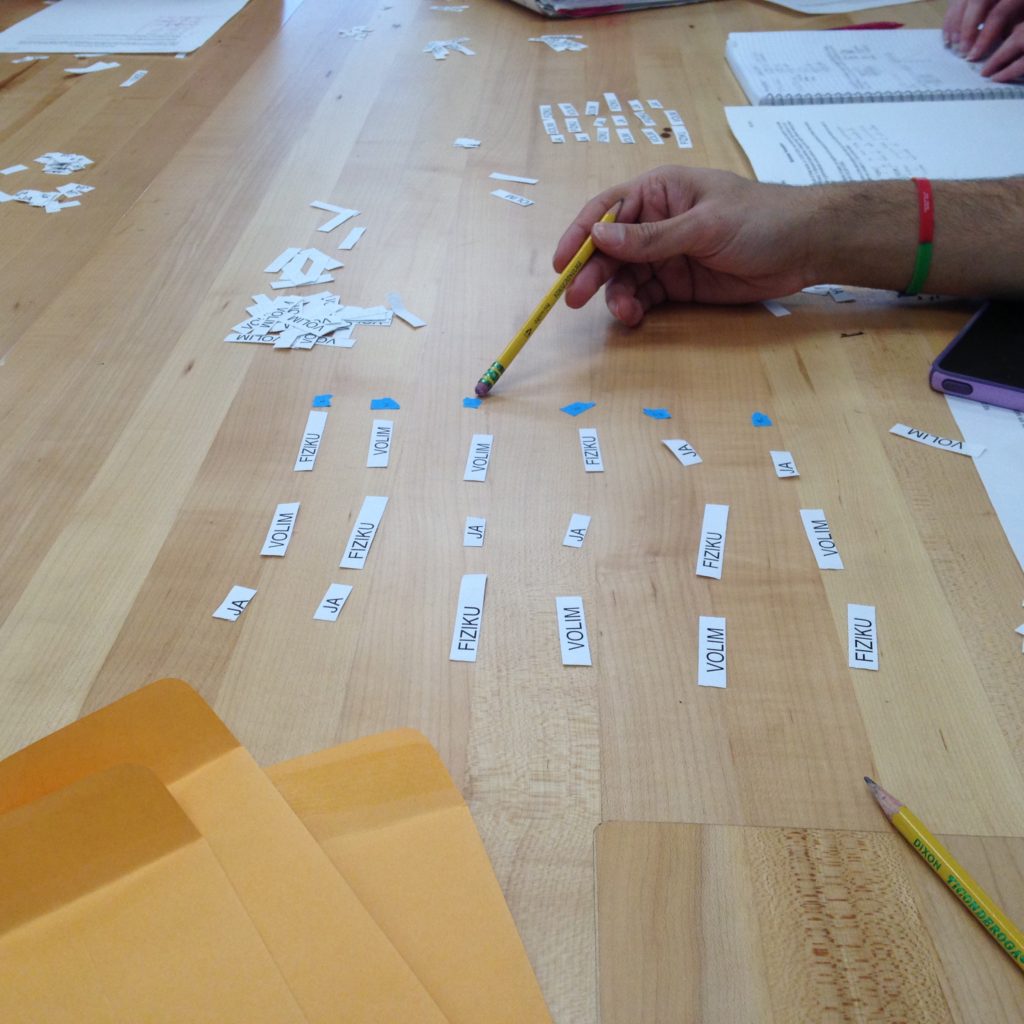 Working on the multiplication table for permutations.
Working on the multiplication table for permutations.
- We inspected the multiplication table to find that these permutations form a group, which led to a formal introduction of the symmetric group S3, and the symmetric groups of permutations in general.
- We concluded the class by drawing parallels to D3, which is isomorphic to S3.
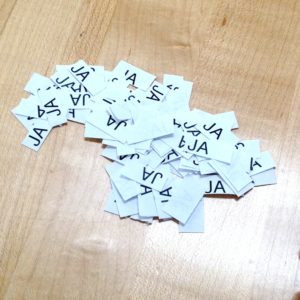
A student noted that this is a very funny pile. -
Discovering Group Theory, Day 10
On Day 10, we continued to talk about subgroups and generators. After going over the basic definition more formally than the last time and cleaning up our notation, we worked out more examples of subgroups of cyclic groups and practiced applying Lagrange’s theorem to find the orders of possible subgroups. We concluded with finding subgroups of D3, from which the takeaway was that there could be multiple instances of a subgroup of the same order. It was not particularly exciting day, but it solidified students’ understanding of the basic concepts. And we also had tea.
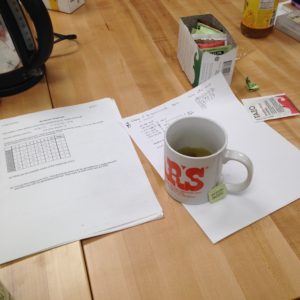
A worksheet on subgroups of D3 and some tea. -
Discovering Group Theory, Day 9
On Day 9, we learned about subgroups. We motivated the concept of a subgroup using rotational symmetries of regular polygons.
Students began the exploration by finding the symmetry group of a cutout of a dodecagon:- identifying the elements of the group,
- finding the order of the group and the order of each element, and
- writing the Cayley table for the group.
Finding the order of each element proved to be a bit involved because one of the elements is of order 12 (and we have been working with low orders, up to 6 at most). So students explained to each other their methods for quickly finding the order of an element by looking at multiples of 12 and using the fact that an element and its inverse have the same order.
Once we figured out that we are dealing with the cyclic group C12, students were asked to overlay cutouts of various other regular polygons on top of the dodecagon and identify which elements of C12 leave the overlaid polygon also unchanged.

Exploring which rotations of a dodecagon leave an overlaid square unchanged. We organized our observations and discovered that those include C3, C4, and C6, which led to a formal definition of a subgroup and the distinction between a proper subgroup and the trivial group, consisting of the identity element. We also found the generators of these cyclic subgroups and noted that the element of order n generates the subgroup Cn.
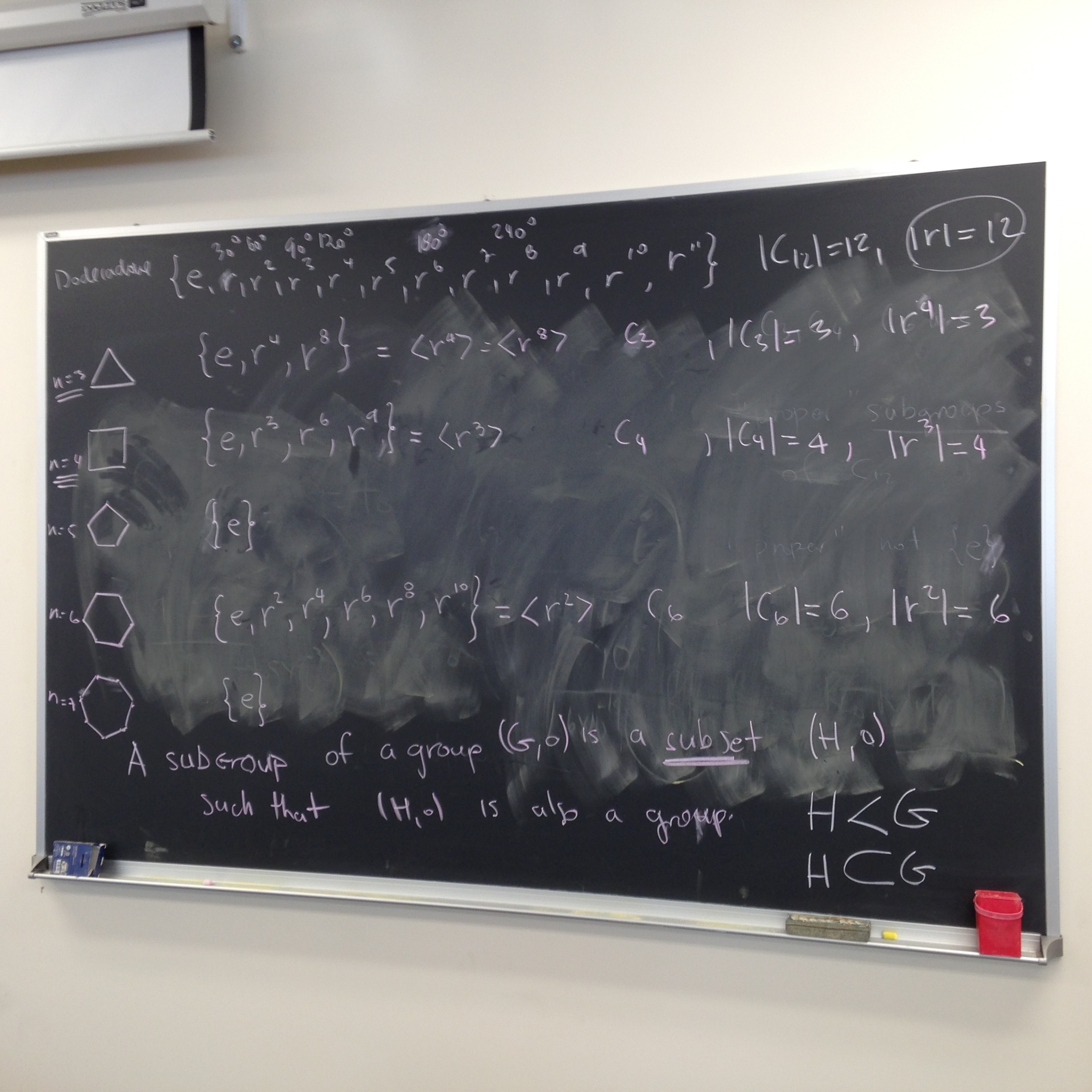
Summarizing the findings from the exploration. The observation of the orders of the subgroups led us to the Lagrange’s theorem for finite groups (though we still haven’t formally introduced the distinction between finite and infinite groups).
On Day 10, we will dig deeper into subgroups and clean up our notation.
-
Discovering Group Theory, Day 8
So far we mostly dealt with groups for which associativity condition is satisfied (multiplication and addition of numbers, successive symmetry operations, etc.). So on Day 8, we started off with some exercises in which student assessed ambiguity of mathematical expressions which lacked brackets. After going through some examples, we briefly reviewed the order of operations rules for addition, subtraction, multiplication, and division. Having understood the importance of mathematical punctuation, we introduced more interesting binary operations on numbers and practiced how to check whether associativity condition holds. This expanded our horizons because we discovered that we aren’t bound to the familiar operations, but could invent our own.
Resources used: F. J. Budden, The Fascination of Groups. Cambridge University Press, 1972. (Reprint with corrections, 1978).
-
Discovering Group Theory, Day 7
On Day 7, we moved on to the symmetries of a square. Using the same methods as for the equilateral triangle, we got the structure of D4, though we left some derivations for a homework assignment. We then made an educated guess about the structure of the symmetry group of a pentagon, D5, and then generalized to the symmetries of an n-dimensional regular polygon, which led us to the formal definition of Dn.
-
Discovering Group Theory, Day 6
On Day 6, we dove into dihedral group D3, which students have been exploring independently as part of their homework and in the context of the symmetries of an equilateral triangle.
- We tackled the group using three methods:
- physically manipulating a cutout of an equilateral triangle,
- drawing diagrams of various operations, simple (single rotation or reflection) and combined (rotation followed by a reflection, etc.), and
- working out the results of combined operations algebraically.This was an attempt to unify the physical experience of manipulating an object, visually representing the effects of those manipulations on the object, and expressing such operations symbolically.
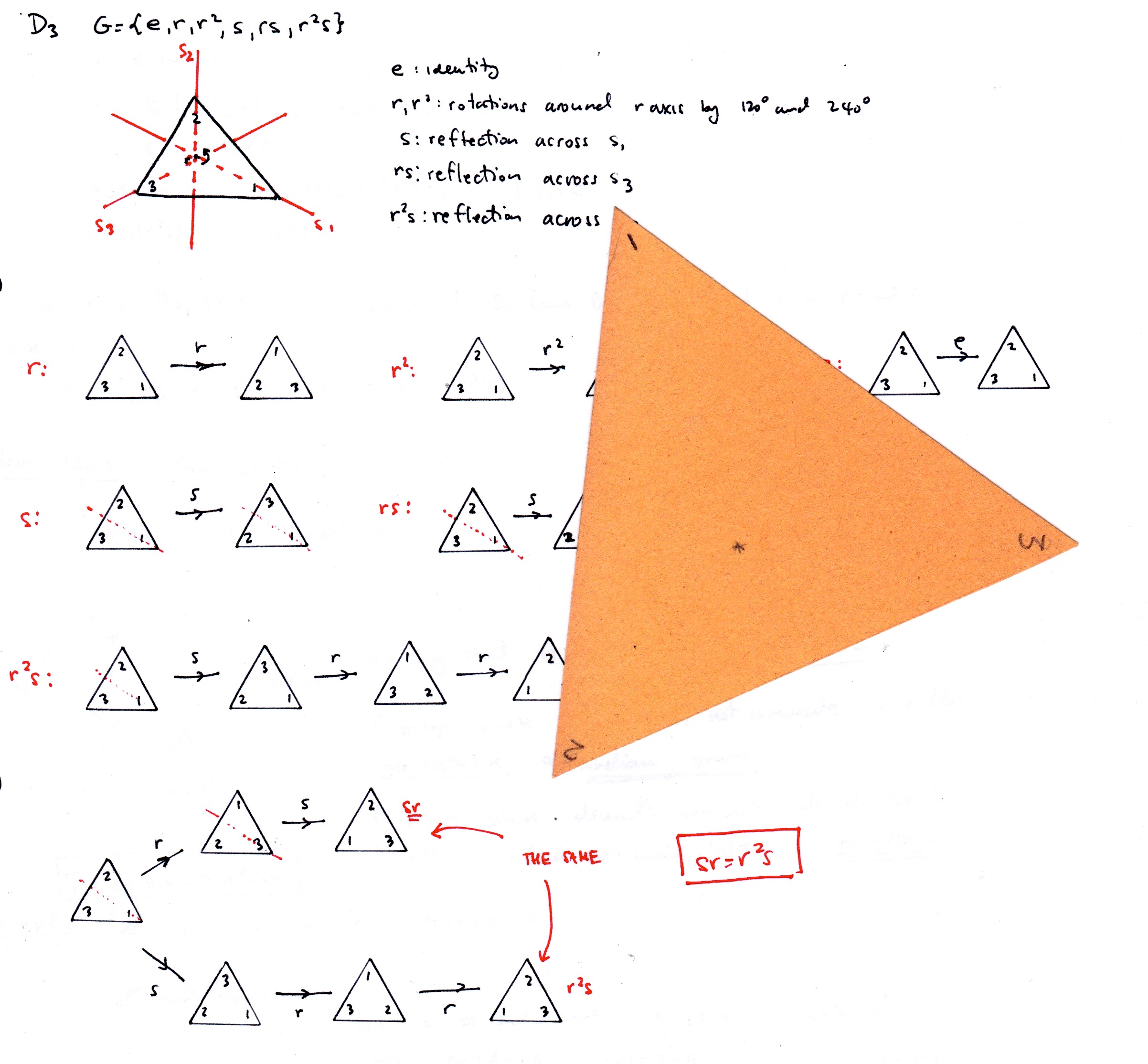
Symmetry transformations of an equilateral triangle.
- We also revisited the already familiar concepts of identity, inverse, generators, group order, and element order, and constructed the Cayley table for D3.
- We noticed that the order in which rotations and reflections are carried out does matter, which motivated the introduction of the commutativity as a property of two elements. This led us to the definitions of Abelian and a non-Abelian groups.
- We tackled the group using three methods:
-
Discovering Group Theory, Day 5
On Day 5, was devoted to the discussion of “Mathematics for Human Flourishing,” a farewell address given by Francis Su at at the end of his term as the President of the Mathematical Association of America.
Students shared their own experiences with mathematics and how those experiences shaped their attitude toward the subject.

An excerpt from Francis Su’s speech. -
Discovering Group Theory, Day 4
Realizing that there was much to be gained from using now familiar cyclic groups to introduce more group properties, we postponed the exploration of dihedral groups and instead spent the day exploring.
- The review of group properties
- After reviewing the structure of particular examples of cyclic groups (C1, C2, C3, C4, and C6) students extrapolated the properties of Cn, which led us to the formal definition of cyclic groups.
- Modular Addition and (Zn,+n)
- We built on our existing knowledge of how to calculate the hour reading of a clock to motivate modular addition. Students were asked to come up with a general mathematical formula which can be used to do the calculations.
- Working in pairs, students then investigated whether (Z4,+4) forms a group by checking if it satisfies the four axioms and constructing the Cayley table. This exercises broadened our understanding of group “multiplication,” which was originally introduced as a way to represent compounding effects of subsequent rotations of a polygon. It became clear why we have been using quotes around the word multiplication.
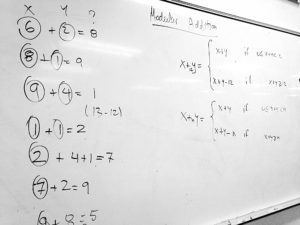
Realizing we already know how to do modular addition. -
- After comparing C4 and Z4, we introduced the idea of a group isomorphism.
- What is Not a Group? Students wanted to know more about when a set and a “product” do not form a group, so we went through a couple of examples in which one or more of the four axioms is violated (especially associativity).
- The review of group properties
-
Discovering Group Theory, Day 3
On Day 3, we did two different sets of activities:
- We revisited the definition of a group and its properties in the context of cyclic groups, namely C1, C2, C3, C4, and C6, encoding the rotational symmetry of polygons we played with on Day 2. Particular features of the cyclic groups prompted a natural introduction to a few new concepts and new terminology:
- Order of a group
- Order of an element of a group
- Group generators
- Group multiplication (Cayley) table, which students worked out for C3, C4, and C6 .
- We began exploring the symmetries of a rectangle, but this time including the reflections. This allowed us study the above-listed concepts in a different context and practice carrying out group multiplication and finding inverses.
The plan was to use 2 to segue into dihedral groups, but it seems more pedagogical to spend another class or two on exploring the cyclic groups in more depth.
- We revisited the definition of a group and its properties in the context of cyclic groups, namely C1, C2, C3, C4, and C6, encoding the rotational symmetry of polygons we played with on Day 2. Particular features of the cyclic groups prompted a natural introduction to a few new concepts and new terminology: